Punjabi Aloo Puri is a timeless North Indian comfort food that evokes feelings of warmth, nostalgia, and celebration. It’s not just a dish—it’s a cherished weekend ritual in many Indian homes, especially on slow Sunday mornings or during festive gatherings with family. This rich and comforting pairing not only pleases the palate but also reflects the depth of cultural tradition behind it.
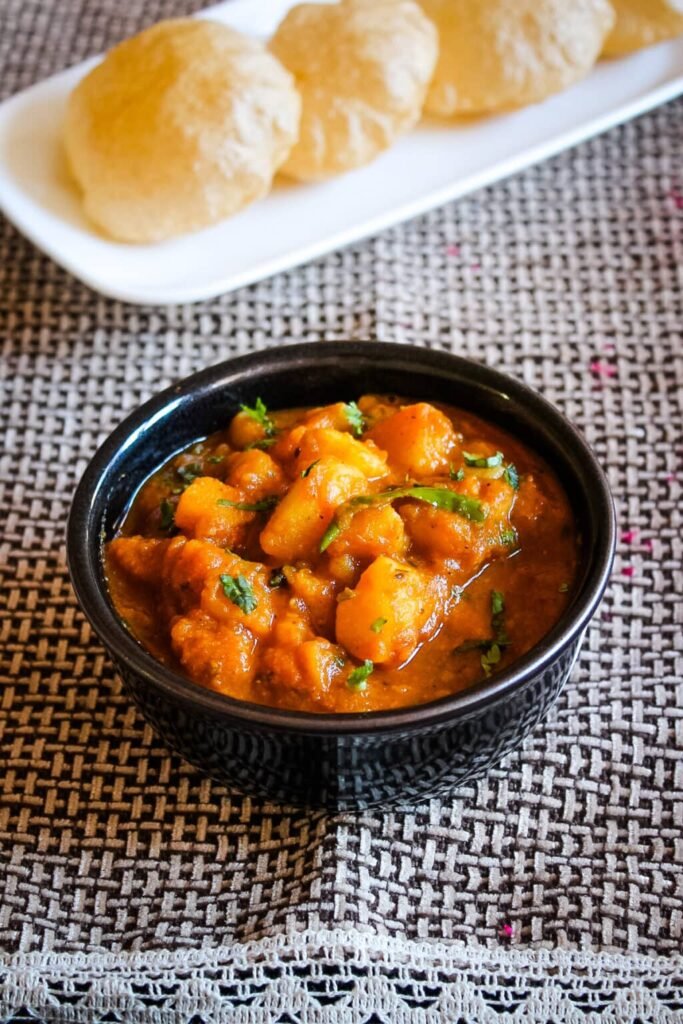
At its core, this Aloo Puri meal brings together two essential components. First is the Aloo Sabzi, a humble yet richly spiced potato curry made with boiled potatoes simmered in a tomato-onion gravy, flavored with a medley of Indian spices. It’s warming, slightly tangy, and full of bold, comforting flavors. The second is the Puri, a golden, puffed bread made from whole wheat flour, deep-fried until light and airy, yet crisp at the edges.
Together, they create a perfect harmony of textures and tastes—the softness of the potatoes paired with the slight crunch of freshly fried puris. Served hot, this duo not only delights the palate but also brings back memories of home-cooked meals and shared laughter around the dining table.
The Aloo Sabzi refers to a mildly spicy, tangy, and flavorful potato curry. Made using boiled potatoes simmered in a vibrant tomato-based gravy, it is delicately seasoned with traditional Indian spices like cumin, turmeric, garam masala, and hing (asafoetida). The tomatoes add a slight tang, while ginger and green chilies bring warmth and a gentle kick to the dish. A pinch of dried fenugreek leaves, known as kasuri methi, is occasionally added to lend a deep, earthy fragrance and enhance the overall depth of flavor.
On the other hand, Puri is a deep-fried, puffed bread made from unleavened wheat flour dough. Rolled into small discs and fried until golden and fluffy, puris are irresistibly soft on the inside with a light crispness on the outside. They serve as the ideal accompaniment to the flavorful potato curry, effortlessly soaking up the aromatic and spiced gravy with every bite.
Whether served on a festive occasion or enjoyed as a weekend indulgence, Punjabi Aloo Puri is a wholesome, satisfying meal that brings people together. Often accompanied by a side of pickles, chopped onions, or even a bowl of curd, this traditional dish is not only hearty and filling but also steeped in cultural nostalgia. Every bite is a celebration of classic Indian home cooking — simple ingredients transformed into something soulfully delicious.
About This Aloo Puri Recipe
1. Breakfast or Brunch Delight:
Aloo Puri is a cherished North Indian dish often enjoyed as a fulfilling breakfast or brunch, particularly on weekends or during festive occasions. Its comforting, flavorful nature makes it perfect for leisurely meals when there’s no rush and everyone gathers around the table to enjoy something indulgent and homemade.
2. Rich and Satisfying Indulgence:
With soft-boiled potatoes simmered in a spiced tomato gravy and paired with deep-fried, puffed puris, this dish is undeniably rich and satisfying. The puris bring a light, crispy texture that perfectly complements the rich, fragrant potato curry, making the entire meal both hearty and indulgent. It’s not just food; it’s a treat for the senses.
3. Perfect for Any Meal:
Although traditionally enjoyed for breakfast or brunch, Aloo Puri is versatile enough to be served for lunch or even dinner. The robust flavors and satisfying texture make it suitable as a complete meal on its own, ideal for both everyday and celebratory menus.
4. Healthier Twist:
If you’re looking for a lighter version, consider replacing puris with plain paratha, phulka, or tandoori roti. The spiced aloo curry complements a variety of Indian flatbreads, making it a versatile and satisfying dish. It can also be enjoyed with a bowl of steamed rice for a simple yet comforting meal. These options help cut down on oil without compromising on taste.
5. No Onion, No Garlic Recipe:
This aloo sabzi is naturally free from onion and garlic, making it ideal for religious fasting days or for those following a sattvic diet. The gravy is prepared using fresh tomatoes, green chilies, ginger, and a blend of everyday Indian spices that offer depth and flavor without needing onion or garlic.
Ingredients for the Aloo (Potato) Gravy:

- Potatoes: For ease and efficiency, I usually cook the potatoes in an Instant Pot. Once they’ve cooled down slightly, I peel off the skin and dice them into small, bite-sized chunks.
- Tip: For Indian-style curries, Yukon Gold or Red-skinned potatoes work best due to their firm texture. I usually avoid using Idaho or Russet potatoes, as they tend to become too mushy.
- Tomatoes: Fresh Roma or Plum tomatoes are my top choice for this curry. Their balanced sweetness and tanginess enhance the overall flavor. I avoid large beefsteak tomatoes, which are too watery and bland for this preparation.
- To make the base, I chop the tomatoes and blend them with a small piece of fresh ginger until the mixture is smooth and creamy.
- Amchur (Dried Mango Powder): A pinch of amchur adds a subtle tanginess that brightens the curry. However, if your tomatoes are already sour (especially if slightly under-ripe), consider reducing the quantity of amchur to maintain a balanced flavor.
Ingredients for the Puri Dough:

- Whole Wheat Flour (Chapati Atta): This is the key ingredient for puri. Do note—this is not the same as the whole wheat flour found in most Western supermarkets. Indian chapati atta is finely milled and yields soft yet puffy puris. It’s easily available in Indian grocery stores.
- Salt – Just a small amount to enhance the taste.
- Oil or ghee is incorporated into the dough to enhance softness and make it easier to roll out.
- Water – Used gradually to knead a firm, non-sticky dough.
- Plus: Oil for deep-frying the puris until golden and puffed.
How To Make Aloo Puri?
Making Aloo Curry (Spiced Potato Gravy):
1) Warm some oil in a deep pan over medium heat. Once it’s hot enough, add cumin seeds. Let them crackle and release their aroma. Then toss in a couple of cloves and sauté briefly for about 30 seconds until fragrant.
2) Pour in the prepared tomato-ginger puree. Be cautious—it may splatter. To avoid mess, partially cover the pan while it cooks.
3) Let the tomato blend simmer until the liquid reduces completely and it transforms into a thick, richly colored paste. This step is key to developing rich flavor.
4) Sprinkle in the basic spices—salt, turmeric, red chili powder, and coriander powder.
5) Stir well and sauté the spices for about a minute to remove any rawness.
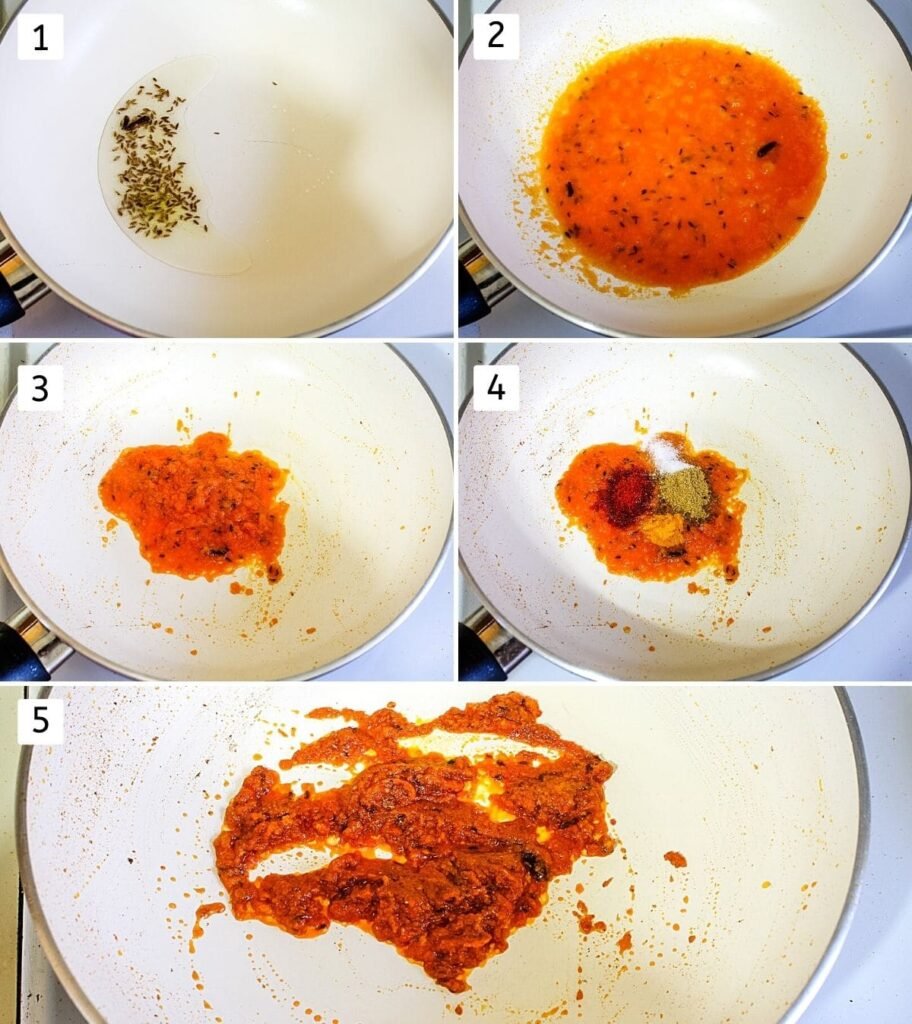
6) Now, add water to adjust the consistency of the gravy. Stir in the boiled, cubed potatoes and slit green chili.
7) Mix everything thoroughly. Simmer the curry over low to medium heat for 8–10 minutes to allow the flavors to develop fully. If the curry becomes too thick, pour in a small amount of water and allow it to simmer a bit longer.
8) Using a spatula, gently mash a few potato pieces in the gravy. This helps thicken the sauce naturally.
9) Stir in a touch of black salt, garam masala, and dried mango powder (amchur) to enhance the flavor with a hint of spice and tanginess. Mix until well incorporated.
10) Top it off with freshly chopped coriander leaves to bring in a touch of brightness and a burst of fresh flavor.
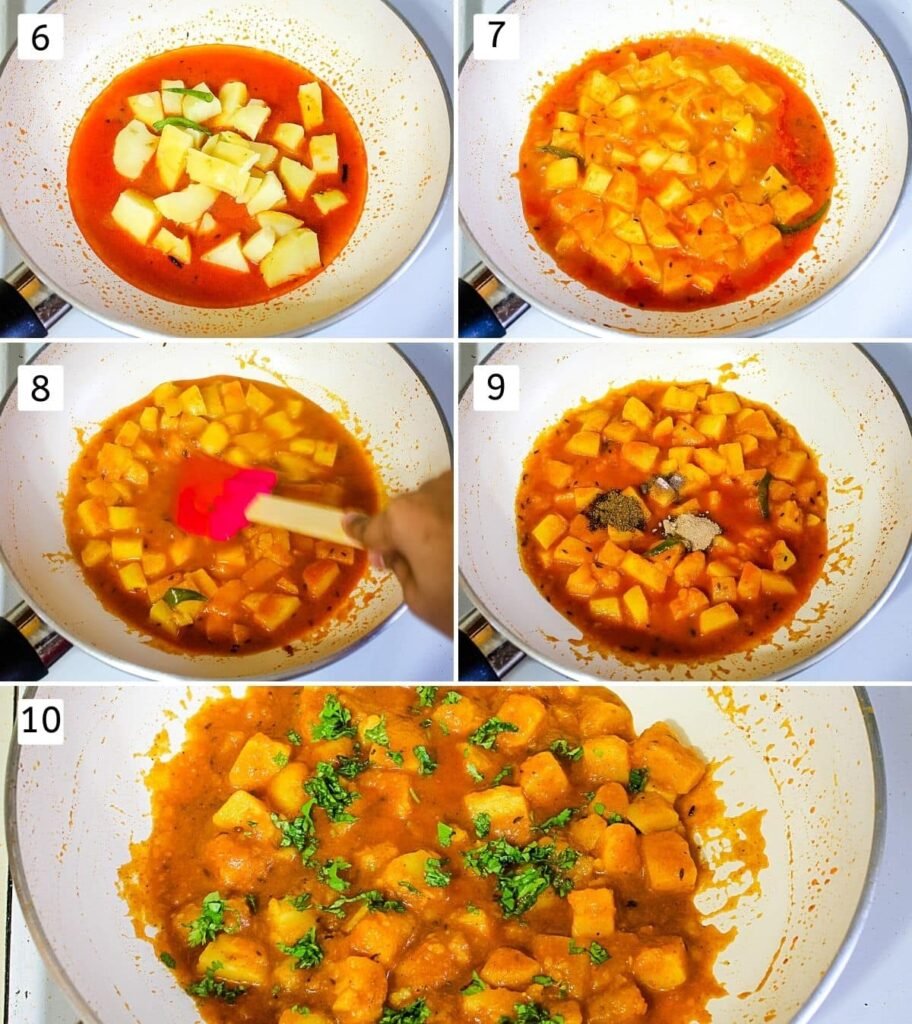
Making Puri (Fried Indian Bread):
1) Start by adding whole wheat flour (chapati atta) and a pinch of salt to a mixing bowl. Mix evenly.
2) Drizzle in a teaspoon of oil or ghee and mix it into the flour with your fingertips until it takes on a crumbly, breadcrumb-like texture.
3) Gradually pour in water and knead to form a dough. Add water little by little to control softness.
4) Knead the dough until it’s smooth and moderately firm—softer than mathri dough but firmer than what you’d make for rotis. Cover with a plate or clean cloth and let it rest for 15–20 minutes.

5) Once the dough has rested, knead it gently for another 1–2 minutes to smoothen it out. Then divide it into 20 to 24 equal pieces and shape each one into a round, smooth ball.
6) Flatten each ball slightly between your palms into small discs. Keep them covered while working to prevent drying.
7) Heat oil in a deep frying pan or kadai over medium heat. While the oil heats, roll each disc into a circle about 3 inches in diameter.
Tip: If the dough sticks while rolling, lightly oil the rolling board and pin—avoid using dry flour, as it can burn in the oil.
8) Roll a few puris in advance and place them on a plate. Ensure even thickness; unevenly rolled puris won’t puff properly.

9) Once the oil is hot, carefully slide in one puri. Gently press the center with a slotted spoon—it will puff up beautifully.
10) When the puri is puffed and the underside turns light golden, flip it over.
11) Fry the other side until it’s lightly golden. Avoid over-frying, as this can make the puri hard instead of soft and fluffy.
12) Remove and place the puri on a plate lined with paper towels to absorb excess oil. Repeat with the remaining puris. Serve hot with flavorful aloo curry for the best taste experience.
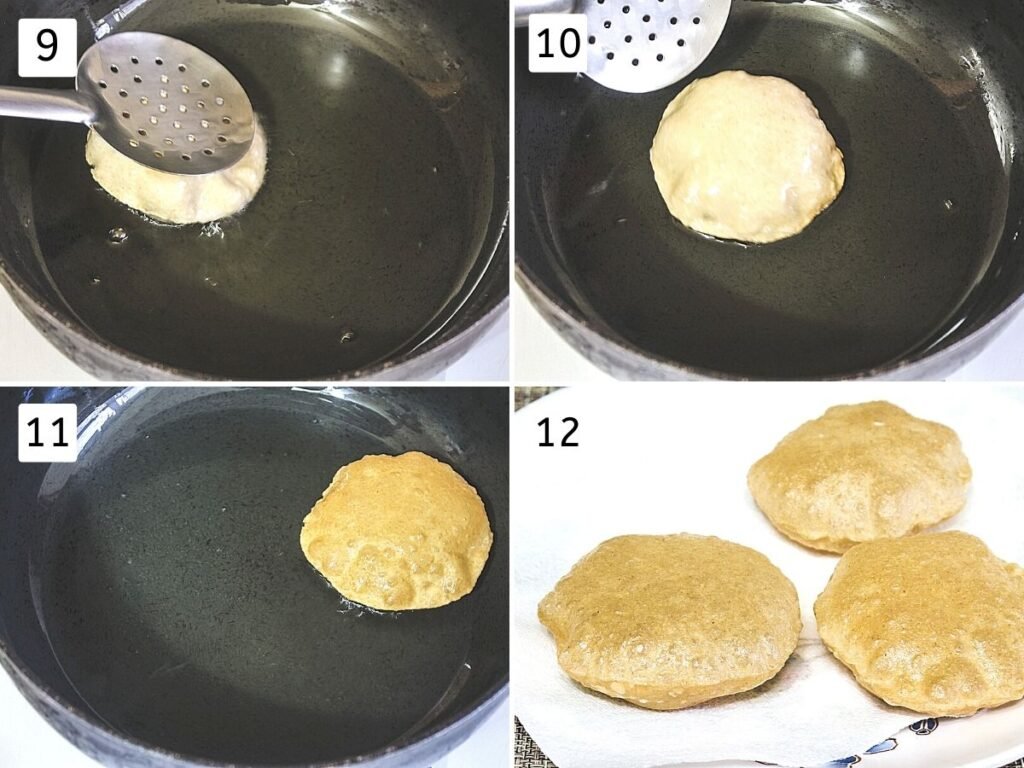
Expert Tips For Making Aloo Puri
Aloo Curry Tips:
1. Choose Ripe Tomatoes:
Always use red, ripe tomatoes for the base of your curry. Unripe or underdeveloped ones can make the gravy overly sour and unbalanced in flavor.
2. Boiling Potatoes:
Potatoes can be cooked either in an Instant Pot or in a regular pressure cooker—typically, 2 whistles are sufficient on the stovetop. Once they’re cool enough to handle, peel the skin and chop them into small cubes.
3. Mash a Few Pieces:
Gently mash a few chunks of potato into the curry as it simmers. This not only helps to naturally thicken the gravy but also adds body and texture.
4. Gravy Consistency Over Time:
The curry tends to thicken as it cools, since the potatoes continue to absorb moisture. If you’re preparing it in advance, keep the gravy a little more fluid to maintain the right consistency when reheated.
Poori Making Tips:
1. Dough Texture Matters:
The dough should be medium-firm, not too soft like roti dough, and definitely not sticky. Begin with a small amount of water and add more only as needed while kneading.
2. Avoid Dry Flour for Rolling:
Skip dusting with dry flour when rolling. Instead, lightly grease your rolling surface and pin if needed. Dry flour burns in hot oil and can leave dark specks on your puris.
3. Roll Evenly:
Each puri should be of medium thickness. Rolling them too thin can prevent the puris from puffing up properly while frying.
4. Keep Covered:
Cover rolled-out puris or flattened discs with a clean kitchen towel to prevent them from drying out before frying.
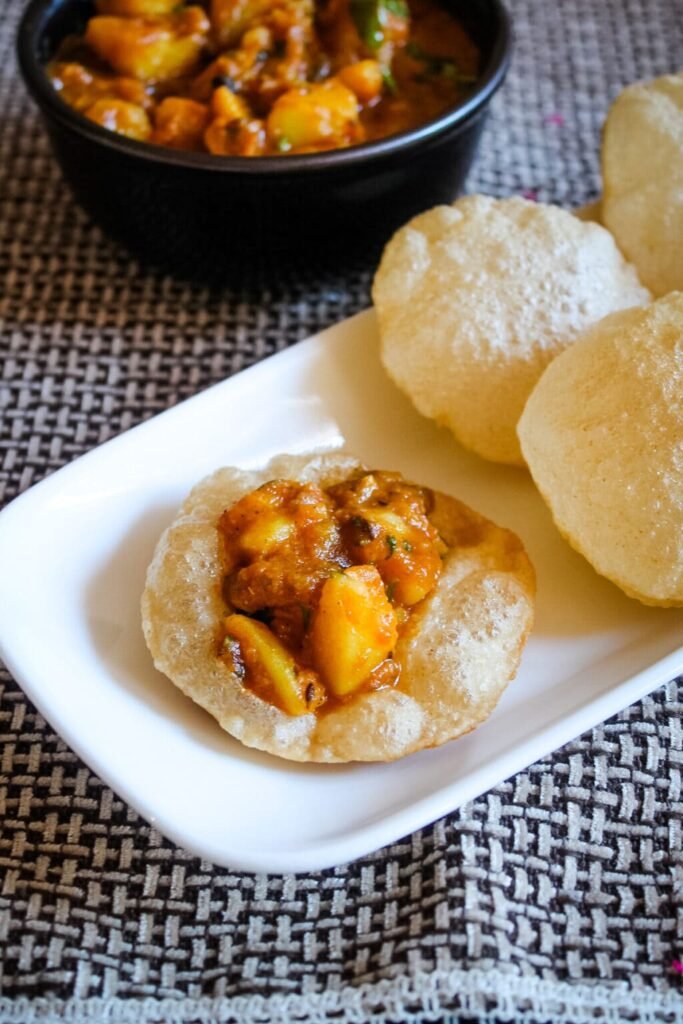
Serving Ideas
1. Ideal for Breakfast or Brunch:
Aloo Puri is traditionally enjoyed as a hearty breakfast or brunch, especially on weekends or special occasions. Its comforting flavors and satisfying texture make it a popular morning indulgence in many Indian homes.
2. Can Be Served as a Main Meal:
Due to its richness and filling nature, this Aloo Puri dish also works well for lunch or dinner. The combination of spicy potato curry and deep-fried puris is substantial enough to serve as a complete meal.
3. Lighter Alternatives:
If you’re looking to reduce calories, consider pairing the aloo curry with whole wheat roti, plain paratha, or even steamed rice instead of deep-fried puris. These alternatives offer a lighter but still flavorful version of the dish.
4. Serve with a Side of Laccha Pyaaz:
A simple side of laccha pyaaz—thinly sliced onions tossed with lemon juice, salt, and a pinch of chaat masala—adds a refreshing crunch and zing that enhances the overall meal experience.
